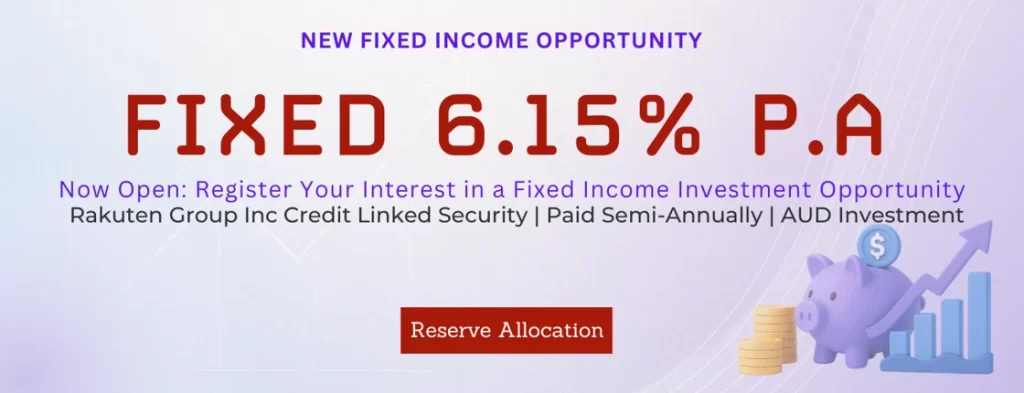Australian Bond Exchange Weekly Update
4th July 2025
Key Points
- Australia: The Reserve Bank of Australia (RBA) lowered the cash rate by 25 basis points to 3.85% p.a. Headline inflation declined to 2.1% year-on-year in May, while core inflation (Trimmed Mean) eased to 2.4%.
- United States: The Federal Reserve kept the federal funds rate unchanged at 4.25%–4.50% p.a. Headline inflation for May printed at 2.4%, with core inflation (ex-food and energy) at 2.8%.
- United Kingdom: The Bank of England (BoE) held the Bank Rate at 4.25% p.a. April inflation rose to 3.5%, up from 2.6% in March.
- Eurozone: The European Central Bank (ECB) reduced its main interest rate by 25 basis points to 2.00% p.a. Inflation for May dropped to 1.9%, dipping below the ECB’s 2% target for the first time since 2024.
- Fixed Income: A new 6.15% p.a. Rakuten Credit Linked Note offering is now available to eligible retail and wholesale investors.
US Tax Bill Passes Both Houses of Congress
The U.S. tax bill officially titled the “One Big Beautiful Bill” (OBBB) has passed both the House of Representatives and the Senate. The House narrowly approved the bill on May 22, 2025, with a 215–214 vote. On July 1, the Senate followed with a 51–50 result, with Vice President JD Vance casting the tie-breaking vote.
The legislation features sweeping Medicaid cuts and more than $3 trillion in tax reductions, primarily aimed at extending the 2017 Trump-era tax cuts. Financial markets, including the bond markets, are worried that these reductions will cause a further blowout in US Government Debt, which could lead to much higher interest rates
US Auto Sales Are Losing Momentum
After a strong spring rebound, U.S. auto sales are showing signs of slowing. The annualised selling rate dropped to 15 million vehicles in June, marking the weakest pace in a year. This is a further indication that economic uncertainty continues to rise and a deeper slowdown could be ahead.
Australian Retail Sales Post Modest Gain in May
Australian retail turnover increased by a modest 0.2% in May, falling short of broader market expectations. Annual growth continued to soften through 2025, easing to 3.3% year-on-year.
May’s growth was primarily driven by a rebound in clothing, footwear, and department store sales, while food retailing declined for the second consecutive month. All major states recorded gains, with Western Australia leading the way, posting a 0.7% increase month-on-month.
Retail performance varied across segments: larger retailers experienced growth, whereas online and smaller retailers saw a decline in sales.
Looking ahead, the June retail trade release, scheduled for July 31, will mark the final edition of this long-running survey. Starting in August, the Australian Bureau of Statistics (ABS) will replace it with the Monthly Household Spending Indicator as the primary early gauge of household consumption. This change will not affect the National Accounts, as the ABS has already incorporated alternative data sources in place of retail trade figures
Fixed Income Opportunity: Rakuten Group Credit Linked Note Now Available
A new 6.15% p.a. fixed income offering from Rakuten Group, Inc. is now open to eligible retail and wholesale investors. This bond pays semi-annual coupons and offers exposure to one of Japan’s most recognised and diversified companies.
🏢 About Rakuten Group, Inc.
Rakuten is a Japanese technology and e-commerce conglomerate founded in 1997 and listed on the Tokyo Stock Exchange. With over 70 subsidiaries operating worldwide, Rakuten is known for innovation and brand trust.
Its operations span multiple sectors, including:
• E-commerce: Rakuten Ichiba – Japan’s largest online marketplace
• Fintech: Rakuten Bank, Rakuten Card, Rakuten Securities
• Digital Content & Communication: Rakuten Viber, Rakuten TV, Rakuten Mobile
• Loyalty: Rakuten Points – Japan’s most widely used rewards system
This level of business diversification provides Rakuten with multiple recurring revenue streams and contributes to its long-term financial stability — key considerations for investors evaluating creditworthiness.
⚠️ Risks to Consider
Please refer to the PDS for full details of the risks.
📘 Example: How Fixed Income Works
A company issues a debt security with the following terms:
Term: 5 years
Coupon: 6.15% p.a., paid semi-annually
Issue Price: $100
Minimum Investment: $10,000 AUD
Investor Scenario Semi-Annual Payments:
Sarah may choose to receive income every 6 months. She receives $3,075 every 6 months (6.15% × $100,000/2). Over 5 years, she also receives $30,750 in total income, plus her $100,000 principal at maturity (subject to no credit event or early redemption).
If she sells before maturity, she may receive more or less than $100,000 depending on market conditions.
📩 Want to learn more or express your interest below
*Data accurate as at 04.07.2025
Disclaimer: This document has been prepared by ABE Distribution Pty. Ltd ACN 673 177 912 Corporate Authorised Representative 1307088 (“ABE”) and is of a general nature only. It was prepared without considering your financial needs, circumstances and objectives. Before investing in a fixed-interest product with ABE, you should consider whether it is appropriate for your circumstances and review the relevant terms and conditions. This document contains links to other third-party websites, some of which require a subscription to read. Such links are for your convenience only, and ABE does not recommend or endorse these third-party sites.. No representation or warranty is made as to the accuracy, completeness or reliability of any estimates, opinions, conclusions, or other information contained in the content. The content may contain certain forward-looking statements. Forward-looking statements are not guarantees of future performance and involve known and unknown risks, uncertainties, and other factors, many of which are beyond our control. To the maximum extent permitted by law ABE disclaims all liability and responsibility for any direct or indirect loss or damage that you may suffer as a result of relying on anything in this content. Past performance is not an indication of future performance



